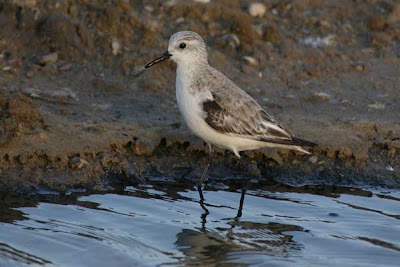On Friday we were at Castro Marim and the surrounding area. It was a relaxed day of ‘social’ birding with our friend, Georg. We hadn’t seen him for a while and there was plenty to talk about but we still managed to find more than 90 species during the day. Highlights included a Purple Heron, several Little Bustards, at least 30 Slender-billed Gulls, a Wood Sandpiper, a Great Spotted Cuckoo and maybe half a dozen Collared Pratincoles. Our visit to what we used to refer to as the disused airstrip at Aldeia Nova was memorable. First of all we noticed that there was actually a light aircraft parked by the derelict buildings and then we saw the police arriving in numbers, followed by a television news crew. The evening news report confirmed what we surmised at the time, that drugs were involved. With evidence in Peter’s passport of a recent visit to Colombia, we were relieved not to be interviewed! From now on it will be called the little-used airstrip.
We returned to Castro Marim late on Saturday afternoon. We had arranged to meet Dave Gosney and his partner, Liz who are currently on a three-month tour of Spain, Portugal and Morocco, working on updates of Dave’s Finding Birds in… books and filming for a new series of DVDs. We saw again a few of the birds seen on Friday, including Little Bustards, Caspian Terns and Slender-billed Gulls but again this was essentially a ‘social’ visit. And naturally we have rather mixed views about bird finding guides!
Tavira saltpans were more or less birdless on Sunday morning. We did see one of the resident ‘grey egrets’, presumed to be garzetta x gularis hybrids, feeding in its usual place at low tide but it was very windy and we soon decided that there more pressing matters to attend to.
Yesterday we had a very good morning at Quinta do Lago. A low-flying Black Kite was the star bird for Elaine and Julie who were with us and we were pleased to see another Purple Heron, our third on successive visits to this site. The tide was high giving good opportunities to photograph a few waders.

Grey Plover
 Whimbrel
Whimbrel

Ruddy Turnstone
We took our picnic lunch to Lagoa dos Salgados. We had been disappointed on our last visit there (18th March) to find that the lagoon had been drained but the latest news was that it had been re-flooded and that on Thursday last week there were lots of birds, including many waders and Flamingos. What another huge disappointment then to find on our arrival that the lagoon was again just a huge area of lifeless mud! It certainly starts to look as though Salgados, in spite of its recognised year round importance for birds, in spite of all the campaigning, press coverage and questions in the Lisbon Parliament, will be after all be sacrificed to the developers. How can anyone want yet another sterile golf course in place of such a wonderful wildlife site?
We did see at Salgados our first Alpine Swifts of the year and we had close-up views by the parking area of the four Northern Bald Ibises that have been there for several months, the ones that absconded from the Spanish re-introduction project. One of the Ibises caught an Iberian Worm Lizard (Blanus cinereous) which caused a bit of a squabble between them.

Northern Bald Ibis with Iberian Worm Lizard

Northern Bald Ibis
We spent the afternoon walking round the marsh at Alvor. Unfortunately, it became very windy and conditions for birding were difficult to say the least. There were about 30 Flamingos present and a selection of waders that included a single Golden Plover which appeared to have an injury to one of its wings, although it managed to fly away from us before we could get a photograph. It was that sort of afternoon.
Work and play? What's the difference?

















































